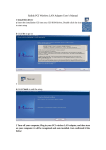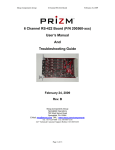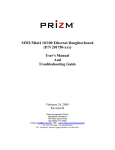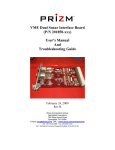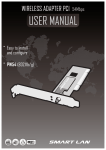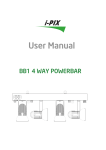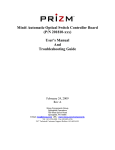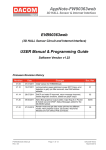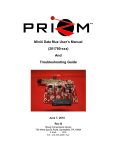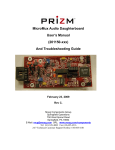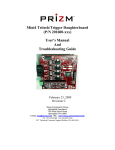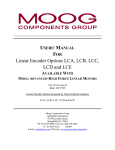Download MiniMux 2 RS-422/485 Daughterboard Manual PN 200860-XXX
Transcript
Moog Components Group Mini-Mux 2 RS-422/485 Daughterboard, Rev B (200860-xxx) February 24, 2009 Mini-Mux 2 RS-422/485 Daughterboard (200860-xxx) User’s Manual And Troubleshooting Guide February 24, 2009 Rev. B Moog Components Group Springfield Operations 750 West Sproul Road Springfield, PA 19064 E-Mail: [email protected] URL: www.moog.com/components Tel: 610-328-4000 Fax 610-605-6216 24/7 Technical Customer Support Hotline: 610-605-6101 Page 1 of 12 Moog Components Group Mini-Mux 2 RS-422/485 Daughterboard, Rev B (200860-xxx) February 24, 2009 TABLE OF CONTENTS 1 Mini-Mux2 RS-422/485 Daughterboard, Part Number 200860-xxx................................................................................3 1.1 Mini-Mux2 RS-422/485 Daughterboard Revision History: ...................................................................... 3 1.2 Mini-Mux2 RS-422/485 Daughterboard Dash (-) Numbers: .................................................................... 3 1.3 Mini-Mux2 RS-422/485 Daughterboard Operation: ................................................................................. 3 1.3.1 Mini-Mux 2 RS-422/485 Daughterboard Indicators and Controls: ...................................................................5 1.3.2 Mini-Mux 2 RS-422/485 Daughterboard Specifications: ..................................................................................9 1.3.3 Mini-Mux 2 RS-422/485 Daughterboard Dimensions:......................................................................................9 1.3.4 Mini-Mux 2 RS-422/485 Daughterboard Power Requirements: .....................................................................10 1.4 RS-422/485 Daughterboard Installation and Checkout ........................................................................... 10 1.5 Mini-Mux2 RS-422/485 Daughterboard Troubleshooting ...................................................................... 10 1.5.1 DC Power Troubleshooting............................................................................................................................10 1.5.2 RS-422 Channel Troubleshooting ..................................................................................................................11 1.5.3 RS-485 Channel Troubleshooting ..................................................................................................................12 Page 2 of 12 Moog Components Group Mini-Mux 2 RS-422/485 Daughterboard, Rev B (200860-xxx) February 24, 2009 1 Mini-Mux2 RS-422/485 Daughterboard, Part Number 200860xxx The Mini-Mux 2 RS-422/485 daughterboard provides the user with an additional four independent RS-422 or RS-485 serial data channels. Each channel can also be independently configured for either RS-422 (4-wire) or RS-485 (2-wire) communications. Each channel is optically isolated, self-powered and transient protected. The Mini-Mux2 RS-422/485 daughterboard connects to the Prizm Mini-Mux2 Video Input and Output boards via a 10 pin header (J1) located at the top left of the board. This header contains power pins(4), data pins(2), clock pins (2), a pin for monitoring link status and a pin for future use. 1.1 Mini-Mux2 RS-422/485 Daughterboard Revision History: The MM2 RS-422/485 daughterboard has gone through the following printed circuit board (PCB) and Assembly revisions: PCB Revision A/Assembly Revision A Original design. 1.2 Mini-Mux2 RS-422/485 Daughterboard Dash (-) Numbers: The MM2 RS-422/485 daughterboard has a Dash Number appended to the part number. This Dash Number identifies the specific board configurations: -001 configuration Original Configuration. 1.3 Mini-Mux2 RS-422/485 Daughterboard Operation: A programmable logic device handles all timing and control functions on the daughterboard. The programmable logic provides the direct connection of the daughterboard serial channels to the Mini-Mux 2 base boards via the daughterboard connector and then on to each of the 4 RS-422/485 serial channels. The daughterboard connection runs at a clock rate of 16.0 or 16.6 MHz, depending in the link direction and the specific clocks placed on the MM2 boards. All four serial channels are timesampled simultaneously at a rate of 2.0 or 2.075Msps (about 1/8 of the sampling rate). The maximum serial channel data rate is limited by the time sampling rate to approximately 660Kbps (about 1/3 of the sampling rate). Page 3 of 12 Moog Components Group Mini-Mux 2 RS-422/485 Daughterboard, Rev B (200860-xxx) February 24, 2009 Each serial channel will support either an RS-422 (4-wire) or an RS-485 (2-wire) configuration by simply changing the appropriate jumper shunts. In the RS-422 configuration, any data rate up to about 660Kbps is supported. In the RS-485 configuration, any data rate up to about 660Kbps is also supported. For RS-485, the placement of a jumper shunt at the appropriate "FAST" jump post may be required if the baud rate exceeds 115Kbaud. Whether this shunt is or is not required is left to the user to determine based on his particular configuration and timing requirements of the RS-485 equipment. There are two 12-pin polarized connectors for the four serial channels. The top left connector, J3, carries serial channels 1 and 2 while the bottom left connector, J4, carries serial channels 3 and 4. The J3 connector has the following signals (RS-422 selected for both channels): PIN 1 2 3 4 5 6 7 8 9 10 11 12 Signal T1T1+ GND_ISOA GND_ISOA R1R1+ T2T2+ GND_ISOB GND_ISOB R2R2+ Signal Direction OUTPUT OUTPUT ISOLATED GROUND ISOLATED GROUND INPUT INPUT OUTPUT OUTPUT ISOLATED GROUND ISOLATED GROUND INPUT INPUT Note1: Pin 1 is located on each connector at the top left side of each connector. Pins 1, 2, 11 and 12 are identified on the silk screen. Note2: GND_ISOA is isolated from GND_ISOB. Pins 3 and 4 are connected together as are pins 9 and 10. The J4 connector has the following signals (RS-422 selected for both channels): PIN 1 2 3 4 5 6 7 8 9 10 11 Signal T3T3+ GND_ISOC GND_ISOC R3R3+ T4T4+ GND_ISOD GND_ISOD R4- Signal Direction OUTPUT OUTPUT ISOLATED GROUND ISOLATED GROUND INPUT INPUT OUTPUT OUTPUT ISOLATED GROUND ISOLATED GROUND INPUT Page 4 of 12 Moog Components Group 12 Mini-Mux 2 RS-422/485 Daughterboard, Rev B (200860-xxx) R4+ February 24, 2009 INPUT Note1: Pin 1 is located on each connector at the top left side of each connector. Pins 1, 2, 11 and 12 are identified on the silk screen. Note2: GND_ISOC is isolated from GND_ISOD. Pins 3 and 4 are connected together as are pins 9 and 10. The J3 connector has the following signals (RS-485 selected for both channels): PIN 1 2 3 4 5 6 7 8 9 10 11 12 Signal RT1RT1+ GND_ISOA GND_ISOA RT1RT1+ RT2RT2+ GND_ISOB GND_ISOB RT2RT2+ Signal Direction OUTPUT/INPUT OUTPUT/INPUT ISOLATED GROUND ISOLATED GROUND OUTPUT/INPUT OUTPUT/INPUT OUTPUT/INPUT OUTPUT/INPUT ISOLATED GROUND ISOLATED GROUND OUTPUT/INPUT OUTPUT/INPUT The J4 connector has the following signals (RS-485 selected for both channels): PIN 1 2 3 4 5 6 7 8 9 10 11 12 Signal RT3RT3+ GND_ISOC GND_ISOC RT3RT3+ RT4RT4+ GND_ISOD GND_ISOD RT4RT4+ Signal Direction OUTPUT/INPUT OUTPUT/INPUT ISOLATED GROUND ISOLATED GROUND OUTPUT/INPUT OUTPUT/INPUT OUTPUT/INPUT OUTPUT/INPUT ISOLATED GROUND ISOLATED GROUND OUTPUT/INPUT OUTPUT/INPUT 1.3.1 Mini-Mux 2 RS-422/485 Daughterboard Indicators and Controls: There are several surface mount diagnostic status LEDs on this board. Page 5 of 12 Moog Components Group Mini-Mux 2 RS-422/485 Daughterboard, Rev B (200860-xxx) February 24, 2009 The SMD LEDs are meant for board level troubleshooting but may be of some limited use to the user in diagnosing a problem. The SMD LEDs are as follows: D4 - labeled “DB PWR +5V” - ON if +5VDC is present on board (from MM2 main board) D2 - not labeled - ON if +5VDC is available on LED Ribbon Header (J2) - ON if fuse F1 is good D5 - labeled “RLINK” - ON if the board is receiving a high-speed link from the other RS-422/485 daughterboard at the other end of the fiber link D7 - labeled “TLINK” - ON if the board is transmitting a high-speed link to the other RS-422/485 daughterboard at the other end of the fiber link Note: The TLINK LED will always be ON. The RLINK LED will blink off during board power-up but then stay on constantly. The following LEDs are used to indicate RS-422/485 data traffic status: D1 - labeled “T1” - ON if RS-422/485 data is being transmitted out of channel 1. D3 - labeled “R1” - ON if RS-422/485 data is being received into channel 1. D6 - labeled “T2” - ON if RS-422/485 data is being transmitted out of channel 2. D8 - labeled “R2” - ON if 422/485 data is being received into channel 2. D9 - labeled “T3” - ON if 422/485 data is being transmitted out of channel 3. D10 - labeled “R3” - ON if 422/485 data is being received into channel 3. D11 - labeled “T4” - ON if 422/485 data is being transmitted out of channel 4. D13 - labeled “R4” - ON if 422/485 data is being received into channel 4. Page 6 of 12 Moog Components Group Mini-Mux 2 RS-422/485 Daughterboard, Rev B (200860-xxx) February 24, 2009 SWITCHES: There are no switches on the RS-422/485 daughterboard. CONNECTORS: J1: The connectors on the RS-422/485 daughterboard are as follows: Daughterboard Connector VDC Supply 1 o RXD 4 3 o GROUND 5 o RXC 7 o RCV LINK 9 o o 2 VDC Supply o 4 TXD 4 o 6 GROUND o 8 TXC o 10 Future J2 LED Display Ribbon Header Connector GROUND 1 o o 2 +5VDC LINK_LED 3 o o 4 TLINK_LED RCV_LINK_LED 5 o o 6 FUTURE_LED R1_LED 7 o o 8 T1_LED R2_LED 9 o o 10 T2_LED R3_LED 11 o o 12 T3_LED R4_LED 13 o o 14 T4_LED GROUND 15 o o 16 +5VDC J3: Channels 1 and 2 Data Connector: T1- (RT1-) 1 o o 2 GND_ISOA 3 o o 4 R1- (RT1-) 5 o o 6 T2- (RT2-) 7 o o 8 GND_ISOB 9 o o 10 R2- (RT2-) 11 o o 12 T1+ (RT1+) GND_ISOA R1+ (RT1+) T2+ (RT2+) GND_ISOB R2+ (RT2+) Note: The first signal label is for RS-422 while the signal label in parentheses is for RS-485. J4: Channels 3 and 4 Data Connector: T3- (RT3-) 1 o o 2 GND_ISOC 3 o o 4 R3- (RT3-) 5 o o 6 T4- (RT4-) 7 o o 8 GND_ISOD 9 o o 10 R4- (RT4-) 11 o o 12 T3+ (RT3+) GND_ISOC R3+ (RT3+) T4+ (RT4+) GND_ISOD R4+ (RT4+) Note: The first signal label is for RS-422 while the signal label in parentheses is for RS-485. JUMPERS: There are 21 jumper posts sets on the Mini-Mux 2 RS-422/485 daughterboard: (PIN 1 DENOTED BY SQUARE PCB PAD) JP1: ISP Programming Header Page 7 of 12 Moog Components Group Mini-Mux 2 RS-422/485 Daughterboard, Rev B (200860-xxx) February 24, 2009 JP2: For Future Use 2 o o 1 JP3: Channel 1 RS-485/RS-422 Selection (T1+ to R1+ connection) 1 o==o 2 RS-485 or 1 o o 2 RS-422 JP4: Channel 1 RS-485 FAST Data Rate Select 1 o 1 o Slow Rate or | Fast Rate 2o 2o JP5: Channel 1 RS-422/485 Configuration Selection 4 o==o 3 RS-485 or 1 o o 3 RS-422 2 o==o 1 2 o o 1 JP6: Channel 1 RS-485/RS-422 Selection (T1- to R1- connection) 1 o==o 2 RS-485 or 1 o o 2 RS-422 JP7: Channel 1 RS-422/485 Receiver Termination Enable 2 o 2 o Unterminated or | Terminated 1o 1o JP8: Channel 2 RS-485/RS-422 Selection (T2+ to R2+ connection) 1 o==o 2 RS-485 or 1 o o 2 RS-422 JP9: Channel 2 RS-485 FAST Data Rate Select 1 o 1 o Slow Rate or | Fast Rate 2o 2o JP10: Channel 2 RS-422/485 Configuration Selection 4 o==o 3 RS-485 or 1 o o 3 RS-422 2 o==o 1 2 o o 1 JP11: Channel 2 RS-422/485 Receiver Termination Enable 2 o 2 o Unterminated or | Terminated 1o 1o JP12: Channel 2 RS-485/RS-422 Selection (T2- to R2- connection) 1 o==o 2 RS-485 or 1 o o 2 RS-422 JP13: Channel 3 RS-485/RS-422 Selection (T3+ to R3+ connection) 1 o==o 2 RS-485 or 1 o o 2 RS-422 Page 8 of 12 Moog Components Group Mini-Mux 2 RS-422/485 Daughterboard, Rev B (200860-xxx) February 24, 2009 JP14: Channel 3 RS-485 FAST Data Rate Select 1 o 1 o Slow Rate or | Fast Rate 2o 2o JP15: Channel 3 RS-422/485 Configuration Selection 4 o==o 3 RS-485 or 1 o o 3 RS-422 2 o==o 1 2 o o 1 JP16: Channel 3 RS-422/485 Receiver Termination Enable 2 o 2 o Unterminated or | Terminated 1o 1o JP17: Channel 3 RS-485/RS-422 Selection (T3- to R3- connection) 1 o==o 2 RS-485 or 1 o o 2 RS-422 JP18: Channel 4 RS-485/RS-422 Selection (T4+ to R4+ connection) 1 o==o 2 RS-485 or 1 o o 2 RS-422 JP19: Channel 4 RS-485 FAST Data Rate Select 1 o 1 o Slow Rate or | Fast Rate 2o 2o JP20: Channel 4 RS-485/RS-422 Selection (T4- to R4- connection) 1 o==o 2 RS-485 or 1 o o 2 RS-422 JP21: Channel 4 RS-422/485 Configuration Selection 4 o==o 3 RS-485 or 1 o o 3 RS-422 2 o==o 1 2 o o 1 JP22: Channel 4 RS-422/485 Receiver Termination Enable 2 o 2 o Unterminated or | Terminated 1o 1o 1.3.2 Mini-Mux 2 RS-422/485 Daughterboard Specifications: Number of serial channels: Connector type: Data rates supported: Isolation provided: 4 x RS-422 or RS-485 12-pin AMP up to 660Kbps optical, self-powered 1.3.3 Mini-Mux 2 RS-422/485 Daughterboard Dimensions: PC/104 printed circuit board (PCB): 3.55 in x 3.775 in x 0.60 in board-to-board Page 9 of 12 Moog Components Group Mini-Mux 2 RS-422/485 Daughterboard, Rev B (200860-xxx) February 24, 2009 (90.17 mm x 95.88 mm x 15.24 mm) 1.3.4 Mini-Mux 2 RS-422/485 Daughterboard Power Requirements: The board requires +5VDC at 250 milliamps. It is powered off of the Mini-Mux 2 Video Input or Output board via a daughterboard connector. A 2Amp through-hole fuse (F2) is provided to protect the board from inadvertent electrical shorts. A 2Amp through-hole fuse (at F1) is provided to protect the board from shorts on the LED ribbon header (J2). 1.4 RS-422/485 Daughterboard Installation and Checkout To properly check out the MM2 RS-422/485 daughterboard, the user must have at two PCs with RS-232 to RS-422 (and/or RS-485) boards installed and operational. These PCs must be correctly configured to communicate via a serial port and have the appropriate serial bit error rate tester (BERT) or terminalemulator software installed. Verify that the PCs can communicate between themselves by attaching them together directly with a short electrical test cable. Once you are sure your test network is operational follow these steps to insert the Prizm System into your network and to prove that the Prizm System is correctly carrying the serial data traffic. 1. Install the Mini-Mux 2 boards with the daughterboard in your system. 2. Install the appropriate fiber optic cables between the Mini-Mux 2 optics. 3. Power up the Mini-Mux2 Surface Video Out and Vehicle Video In cards. 4. Verify that all boards power up correctly and show the appropriate status LED indications. 5. Verify that the Mini-Mux 2 main boards are linked via the fiber cables and that no optical errors are being reported. 6. With no RS-422 and/or RS-485 cables attached to either of the Mini-Mux 2 RS-422/485 daughterboards, verify that both boards have the top right two LEDs lit (RLINK and TLINK) and the top left LED lit (DB PWR +5V). 7. Plug the RS-422 and/or RS-485 cables from two of the test PCs into the appropriate serial connectors (J3 or J4) on each board. 8. Attempt to run the serial test communications from one test PC to another test PC. The serial test program should show that there is communications between the PCs and the error rate. 1.5 Mini-Mux2 RS-422/485 Daughterboard Troubleshooting In normal operation the following LED status should be observed with the RS-422/485 daughterboard plugged into MM2 main board with no RS-422 and/or RS-485 cables attached: 1.5.1 DC Power Troubleshooting The SMD LEDs are as follows: D4 – ON (DB PWR +5V) D5 – On (RLINK) Page 10 of 12 Moog Components Group Mini-Mux 2 RS-422/485 Daughterboard, Rev B (200860-xxx) February 24, 2009 D7 – On (TLINK) The remaining LEDs will be off. The LED status conditions of the RS-422/485 daughterboard are detailed for several scenarios assuming two test PCs. The statuses are as follows: 1.5.2 RS-422 Channel Troubleshooting For this troubleshooting, it is assumed that all 4 serial channels are configured for RS-422 operation on both the "Local" and "Remote" RS-422/485 daughterboards. 1. Ensure that the Prizm Mini-Mux 2 system is fully functional and a PC that is running a serial communications program (i.e. terminal or hyperterminal) is plugged into RS-422 channel 1 of the "Local" RS-422/485 daughterboard. A loop-back cable is plugged into the "Remote" RS-422/485 daughterboard data header to loop RS-422 data back to the "Local" RS-422/485 daughterboard set: At the "Local" end (with the PC connected and serial data being generated): RLINK LED (D5)- ON green solid TLINK LED (D7)- ON green solid T1 LED (D1) - ON red or blinking ON with RS-422 traffic from "Remote" end R1 LED (D3) - ON green or blinking ON with RS-422 traffic into board T2 LED (D6) - OFF R2 LED (D8) - OFF T3 LED (D9) - OFF R3 LED (D10) - OFF T4 LED (D11) - OFF R4 LED (D13) - OFF At the "Remote" end: RLINK LED (D5)- ON green solid TLINK LED (D7)- ON green solid T1 LED (D1) - ON red or blinking ON/OFF with RS-422 traffic from "Local" end R1 LED (D3) - ON green or blinking ON/OFF with RS-422 traffic (looped back) T2 LED (D6) - OFF R2 LED (D8) - OFF T3 LED (D9) - OFF R3 LED (D10) - OFF T4 LED (D11) - OFF R4 LED (D13) - OFF 2. Now move the data cable connection from RS-422 channel 1 to channels 2, 3 and then 4. Also move the loop-back cable follow the channel under test. The same LED statuses should be observed as above except moved from channel 1 to 2 to 3 and then to 4, as appropriate. Page 11 of 12 Moog Components Group Mini-Mux 2 RS-422/485 Daughterboard, Rev B (200860-xxx) February 24, 2009 1.5.3 RS-485 Channel Troubleshooting For this troubleshooting, it is assumed that all 4 serial channels are configured for RS-485operation on both the "Local" and "Remote" RS-422/485 daughterboards. Note: A PC that is running a serial communications program (the host) that supports RS-485 (i.e. the Prizm PMON program, for example) and a slave PC or stand-alone computer that communicates with the RS-485 program (i.e. the Prizm Modem 2 board with Diagnostics) must be employed to test an RS-485 channel. 1. Ensure that the Prizm Mini-Mux 2 system is fully functional and a host PC is plugged into the RS-485 channel 1 of the "Local" RS-422/485 daughterboard and a slave computer is plugged into the RS-485 channel 1 of the "Remote" RS-422/485 daughterboard data header. At the "Local" end (with the host PC connected and running): RLINK LED (D5)- ON green solid TLINK LED (D7)- ON green solid T1 LED (D1) - ON red or blinking ON with RS-485 traffic from "Remote" end R1 LED (D3) - ON green or blinking ON with RS-485 traffic into board T2 LED (D6) - OFF R2 LED (D8) - OFF T3 LED (D9) - OFF R3 LED (D10) - OFF T4 LED (D11) - OFF R4 LED (D13) - OFF At the "Remote" end: RLINK LED (D5)- ON green solid TLINK LED (D7)- ON green solid T1 LED (D1) - ON red or blinking ON/OFF with RS-485 traffic from "Local" end R1 LED (D3) - ON green or blinking ON/OFF with RS-485 traffic (looped back) T2 LED (D6) - OFF R2 LED (D8) - OFF T3 LED (D9) - OFF R3 LED (D10) - OFF T4 LED (D11) - OFF R4 LED (D13) - OFF 2. Now move the data cable connections from RS-485 channel 1 to channels 2, 3 and then 4. The same LED statuses should be observed as above except moved from channel 1 to 2 to 3 and then to 4, as appropriate. Page 12 of 12
















